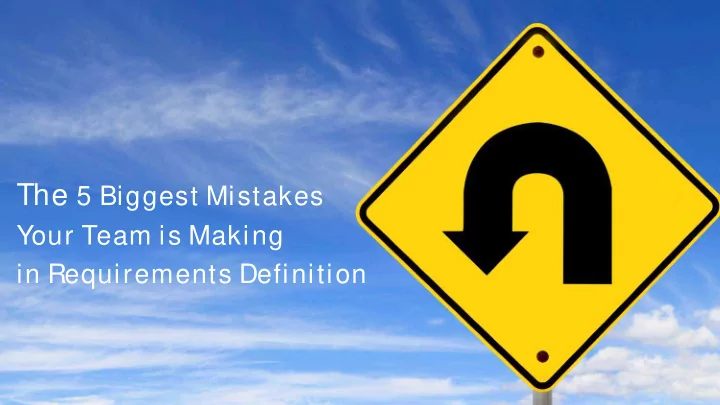

The 5 Biggest Mistakes Your Team is Making in Requirements Definition
About this session Kathryn E. Campbell UX & Digital Product Strategy Consultant @pspark_kc #5mistakes #productdesign
Mistake # 1: Thinking too small Mistake # 1: Thinking Too Small
One important thing “In SAAS, if you are 10x better at One Important Thing that customers value and will pay for, that’s enough. Many founders build a key feature that is indeed 10x better — but not one important enough to pick a new vendor to get.” Jason Lemkin, Silicon Valley VC, Founder SaaStr
Questions to generate ideas ● What trends are impacting the way my clients do business? ● What growth segments do I not currently serve that I could? ● What technology trends might they benefit from? ● What could I do to significantly impact their business results?
Mistake # 2: Being Stuck in the Past Mistake # 2: Being stuck in the past
E xplore new tech in parallel
Mistake # 3: Assuming too much
Ask. Listen. “Go to your users. Get to know them. Get your customers one by one.” ― Paul Graham, of Y Combinator, to Brian Chesky on how to build Airbnb (Masters of Scale podcast with Reid Hoffman)
The Fix: Continuous Validation
Fast, affordable user insights ● Tech support/customer service reviews ● Conferences ● Site visits ● Unmoderated testing (e.g. Usertesting.com) ● Conference room “lab” ● Other ideas?
Mistake # 4: Rarely saying no
The Fix: Show the Cost
Use themes to focus roadmaps “A theme is a group of features tied together by a simple, clear benefit, usually to the user.“ Focus on a small number (1 – 3) of overarching themes oriented around solving customer problems. Exclude distracting features that don’t relate to the problem at hand. ― See articles by Bruce McCarthy & Jared Spool
Ways to say no ● Use themes to enforce focus. ● Let your users deliver the bad news, so you don’t have to. ● Measure perceived complexity. ● Measure & report on features that are rarely or never used. ● Do a “prescribed burn” regularly to remove features that aren’t being used.
Mistake # 5: Jumping to the answer
Define before you design Define Design Develop Deploy Define = WHAT capability is needed. Design & Development = HOW to do it.
Samp mple fea eatu ture ma matri trix
Build the right it “Most prototypes are built to answer questions such as, ‘Can we build it?’ or ‘Will it work as expected?’ instead of focusing on questions such as ‘Should we build it at all?’ or ‘If we build it, will people buy it and use it?’ Make sure you are building The Right It before you build It right .” ― Alberto Savoia, Google’s Innovation Agitator, Author
Be a change agent ● Always ask for user validation. ● Expose the entire product team to user input whenever possible. ● Build allies for cultural change. ● Learn to speak the language of business!
Thank you!
Recommend
More recommend